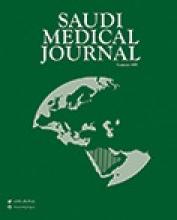Abstract
OBJECTIVE: To determine the prevalence, severity and pattern of caries in preschool children of Al-Ahsa, Kingdom of Saudi Arabia.
METHODS: Three hundred and twenty two randomly selected pre-school children were examined in kindergartens of Al-Ahsa, Kingdom of Saudi Arabia for dental caries using World Health Organization criteria for the diagnosis of caries. The study was completed in 2000.
RESULTS: The mean decayed missing and filled teeth score in the 322 pre-school children examined was 2.92 (standard deviation 3.51) with decay component as the major contributor in the decayed missing and filled teeth score. The difference between mean decayed missing and filled teeth scores was not significant in relation to gender, type of kindergarten (government or private) and area (urban or rural). The difference between mean decayed missing and filled teeth scores of 4-year-old and 5-year-old children was statistically significant. Of the 322 children examined, 202 (62.7%) were caries positive. There was no significant difference for caries prevalence in relation to gender, type of kindergarten and area. But, the difference in caries prevalence between various age groups was statistically significant. The mandibular first molars were the most carious teeth followed by mandibular 2nd molars and maxillary central incisors. The least affected teeth were mandibular central incisors.
CONCLUSION: The mean decayed missing and filled teeth score and caries prevalence in the studied pre-school children is high as compared with children from developed countries. A major decay component indicates a high percentage of untreated caries. A high percentage of carious maxillary incisors indicate a nursing caries pattern.
- Copyright: © Saudi Medical Journal
This is an open-access article distributed under the terms of the Creative Commons Attribution-Noncommercial-Share Alike 3.0 Unported, which permits unrestricted use, distribution, and reproduction in any medium, provided the original work is properly cited.






